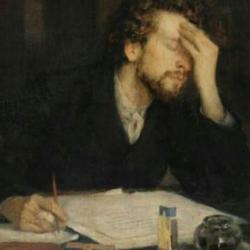Marjorie Garber on Midsummer Night?s Dream .
1) She begins by explaining the various connections between MSND and Romeo & Juliet , suggesting that MSND is a comic version of R&J . In both, an authority figure stands between the lovers; in both they seek satisfaction by escape; in both, the disobedient girl is threatened with confinement to a nunnery; and both employ similar images of night/day, the nightingale and the lark. This point is strengthened all the more by the R&J -like play that concludes MSND , which shows the tragic potential of the romantic story in the main action of the play.
2) MSND begins with a wedding, normally, as Garber points out, the conclusion of a comedy. But that does not make the story superfluous. Theseus has wooed Hippolyta ?with my sword,?Eand needs to transition to ?another key?Eto make the marriage work. But that is not an easy transition. Hermia might well think that Theseus is forcing her to woo ?by sword?Ewhen both her father and Theseus insist that she marry Demetrius against her will. Indeed, Theseus threatens the death penalty. Hence, this play, like so many of Shakespeare?s comedies, is about the conflict between love and law, between passion and order/reason. Garber puts it well: ?it appears that both the authoritarian father and the authoritarian duke have a good deal to learn about the way love breaks old rules and makes for new ones.?EThis fits with comments from James Jordan I posted earlier this week, for it is ultimately the reckless act of divine love that shatters the old and brings in the new. Grace (or magic) and love in MSND are not comforting, but disorienting, destroying settledness and challenging the fixed rules on which, we believe, all order depends.
3) Garber includes various intriguing details about Elizabeth I, though these are (to my mind) only tangentially related to the play. Elizabeth was often thought of as an Amazon during her reign, since she was in the odd position of being a woman ruling men. In contrast to Hermia, for whom the prospect of perpetual virginity is a curse, Elizabeth was able to play her virginity to increase her power, playing both the role of queen and the role of potential bride. Interestingly, she saw herself as the bride of England, wearing her coronation ring in place of a wedding ring. And there was a curious connection between her virginity and her role as queen, an almost Pauline sense of vocation. She wrote in 1563 that marriage might work for a ?private woman?Ebut though ?it is not meet for a Prince.?EFreed from the obligations of a husband, she could devote herself wholly to England. Finally, though ?Prince?Ein Elizabethan English doesn?t always carry the gendered sense that it carries for us, there is something striking about how she employs a masculine title in speaking of herself.
4) Confusions abound of course in the play, but Garber points to the fact that these confusions are often confusions about one?s own identity. ?Am not I Hermia? Are not you Lysander??EAs noted in my discussion of Timon of Athens , the implied ?anthropology?Eis a relational one; Hermia doubts she?s Hermia because she is not longer loved by Lysander. We are who we are in the gaze of another, as our gaze is affected and formed by their gaze. There is another aspect of this that might be explored more fully: The two male characters, Garber notes, are virtually indistinguishable, and for them (at least during the night in the wood) the two women become interchangeable, distinguished only by height. Do the men ever get individualized? How? Another (Girardian) factor is love itself, which pits the two men as rivals (distinguishing them) who manifest identical desires (thus blurring the distinction). Similarly, the women are individualized in part by love; they were inseparable as children (3.2.204ff), a two-in-one, but desire separates and turns them into rivals, distinguishing them more completely and persistently than the men ever get distinguished; the ladies, at least, never shift in their objects of affection. Strangely, the women are the ones who form their settled affections in the rational world of the city; it?s the men that need an infusion of magic to make things run. Garber points out that the Athenians, given their social roles in the city, cannot remain in the uncertainty of the dream-identity forever; but once they have been dissolved, the re-constituted identity will be richer, and different. Losing oneself to find oneself again.
5) Explaining the sequence of court-country-court, Garber points to the multi-layered pun that occurs when Demetrius calls Helena ?wood within this wood?E ??Wood, derived from the Old English word wod , means ?mad?Eor ?lunatic.?EHe is maddened, and also ?wooed?E(by Helena), within the wood. But to be wood within the wood is also to become part of the wood, to take on its qualities, to become transformative and changeable as the wood itself.?EMidsummer Dream is also midsummer madness, and Garber notes the widespread myth that madness and witchcraft permeated the world at Midsummer, on the longest day of the year.
6) Garber nicely points out the variety of transformations that occur in the wood. Some are figurative (marked by changing names and descriptions) and others are literal (such as the male lovers?Echange of affection or Bottom?s transformation). But the play raises the question of whether the transformations are in fact transformative, and this question is most pointedly raised in connection with Bottom: Does he become an ass? Or does his assization merely manifest what was already true about him? With Bottom, the answers seems to be the latter, but then we are forced to ask whether the same is true of the other characters? Is Lysander?s apparently magical change into a lover of Helena really a change, or does it manifest something latent in the previous situation? Does Titania?s infatuation with an ass unmask something about her or change her? The fact that Titania and Oberon are engaged in a conflict of mimetic desire over the Indian changeling boy, throwing the wood into chaos, suggests the possibility that her desires are disordered from the beginning. Are her desires already somehow bestial when the play begins?
7) The play ends with a play within a play, but the whole play can be seen as worked out in three interlocked theaters, each of which has a ?stage manager?E Theseus rules Athens; Oberon the wood; and Peter Quince the mechanicals. These are the political world, a literalized magical world where metaphor becomes manifest as allegory, and a world of art; or, as Garber suggests, the conscious (day) world, the world of the unconscious (night/dream/magic), and the world of art and fantasy. Each stage reflects on the others, since each is populated by folks who fit into Theseus?Escheme of the ?seething brained?Ein Act 5: The lunatic, the lover, and the poet. Which world is preferable? Theseus?Efamous speech is a defense of reason against imagination, but reason doesn?t work well in the play. Theseus?Ereasons of law threaten Hermia with death and lead to her flight from the city; Lysander defends his love for Helena with another appeal to reason (2.2.121-122). But the wood, as ?a place of dream and wish fulfillment, of lust and libido,?Ealso has its drawbacks. Puck is meanly prankish. The desires unleashed in the wood, however, threaten the final happiness of the characters (for a time) just as much as the controlling reason of Athens. The players are low on the scale of being, heavy and slow especially in comparison to the fairies; even their names are grossly physical (Snout, Bottom). Garber suggests that the low characters, and particularly Bottom, ?point up by contrast the shortcomings of the aristocrats.?EBottom moves from weaver to actor to ass to the ?sweet-faced lover?EPyramus with ?unflagging zeal, equanimity, and enthusiasm.?EBottom alone discerns that ?reason and love keep little company
together nowadays.?EThe players, more than the lovers, recognize the potential dangers of illusion and fantasy; though their concern that the lion not fright the audience is played for comedy, it manifests an awareness that imagination poses dangers as well as delights: ?Role-playing is dangerous . . . The condition of being an actor is a condition akin to the performance of magic . . . . The dangers of the irrational can be combated only by a safe retreat to reality,?Eonly by breaking the frame and informing the audience that ?he is Snug the joiner.?E
8) Garber summarizes the play?s balance of reason and passion, suggesting that MSND ?strikes a careful, though also a playful, balance between ?cool reason?Eand the dangers of the irrational. And those dangers are everywhere. There is freedom in fleeing from a repressive parent and a repressive law, as Hermia does, to follow her lover into the wood; there is freedom and possibility in choosing love and marriage over the nunnery. But there is a parallel danger, as we have seen, in excessive sexuality and desire: in the dream of the snake invading Hermia?s little Eden, and in the example of Titania doting blindly on the transformed Bottom . . . . There is danger, too, in the very ambiguity of the wood. The same attributes that make magic possible also make it dangerous. Around the edges of this enchantment lurks the possibility of real madness, as contrasted with the delicious ?midsummer?Evariety, the state of the lunatic rather than the lover or the poet.?E
9) How is this balance struck? How are the claims of reason and the claims of imagination brought together? How can imagination evade lunacy without becoming imprisoned to reason? Garber suggests that the answer of the play is that art provides the medium. The Pyramus and Thisbe play exemplifies this: ?performed by social inferiors for their putative betters, [the play] confronts the themes, aspirations, and pretensions of the aristocrats and comments on the larger play that contains it.?EThe artistic rendering of the tragic story, the tragic story that MSND might have been, reduces the tragedy ?to a manageable, bearable, and laughable fiction.?EAnd the play picks up the threats that have dogged the characters throughout the play: Bottom speaks of the lion ?deflowering?EThisbe, raising the threat of rape that goes back to Theseus?Eopening lines; the monstrous attack of the lion is reminiscent of the monstrous love of Titania. But these threats are ?neutralized?Eby comedy: ?The ?Pyramus and Thisbe?Eplay neutralizes and makes manageable all the dangers they could have encountered. And it is a measure of their own limitation that none of the noble spectators can see any connection between the play they are watching and the one they are in.?E
10) The concluding play within a play also highlights the Shakespearean insight that all the world is a stage: ?A play is a fiction, art is an illusion, ?no more yielding but a dream.?ECan we be blamed if we wonder ?Enow that we have been told that we are reality ?Ewhen someone else will wake and recognize that we are only dream? Can we be blamed for looking over our shoulders, and wondering who is watching the play in which we are acting, while we watch, onstage, actors watching actors who play actors performing a play??E















